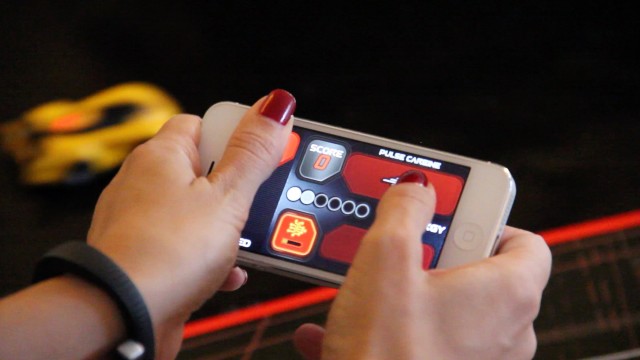Anki is the Christmas gift you’ll buy for your kids and then steal for yourself.
Do you need Anki? No. Is it going to help you be more productive at work? No — probably less. Will it make your photos look better? Will it work on a timer and vacuum your floors? Can you use it to quiet your child during a long flight? Nope, none of that.
Anki is a set of robotic toy cars that create the same experience in the physical world you’d normally have with a racing videogame. So, with regular, physical remote-control cars, you would control a car, and your friend would control another, and so on.
With Anki, you use an iPhone, iPad or iPod touch to control your toy car. The cars that are not being steered by you or your friends are actually robots, and they’re racing against you and reacting in real time, just like in a digital video game.
They all work on a special racing track, a flat black mat, that has a bunch of positioning data baked into it. The cars read this data through a tiny camera and then send the information back to your iPhone via Bluetooth.
This past week, I played with Anki a handful of times, mostly at night, when I wanted to decompress from the day. The whole toy set feels really well made, and it works as promised.
The downside of Anki is its price. The starter kit, which includes the racing mat, two toy cars, their charging pods and a tire cleaner, costs $199. Each additional car costs $69. There are currently four cars available. A fifth, special-edition car is being developed.
When you consider that Anki is bringing robotics and artificial intelligence to such a consumer-friendly level, $199 might not seem like a lot. But I still think that’s a really hefty price for a kid’s toy — plus, you’ll need that iOS device or two. (Good thing that it’s fun for adults, too.)
Also, it’s iOS-only, which is bad news for Android users. And, while Anki cars charge in about eight minutes, their battery also drains pretty quickly. So you’ll need to keep recharging them, which breaks up game play.
Here’s how the set-up works: You first download the Anki Drive app from the iTunes App Store. The app is free. Then, you activate Bluetooth on your iPhone. This is how the cars wirelessly connect to the phone, or iPad.
First-time users can go through a tutorial in the app, and normally I’d say skip it but this part is actually sort of cool. You plop the cars on the mat, give them a nudge and they take off, fighting for position on the loop. It’s in this instant, before the games have begun, that you get a sense of how robotics and artificial intelligence works within these tiny toys.
The cars look like brightly-colored little Batmobiles, complete with glowing lights. Their names might as well be picked off signs at a science fair: Boson, Kourai, Rho (these are the three I tested) and Katal.
The object of the Anki game is to eliminate your opponents by virtually shooting at them while you’re racing around the track. You also want to rack up points and medals for yourself so you can upgrade your car.
Each car, in addition to having a different name and color scheme, also has a unique skill set, which you can view in the app. Some are faster. Some are more agile. Some have stronger defenses.
When you’re ready to race you can choose to play with friends in the room with you, or, you can play against the AI cars. I found the Anki app to be responsive and easy to use. It has a slider bar that adjusts your speed, and you steer your car by tilting your mobile device. On the right-hand side of the screen are two buttons for your car’s defense and artillery systems. When you’re being shot at by an opponent, your app will flash red.
Playing this game is fun. I alternated playing by myself against a robot car or racing against my boyfriend and a robot car. The racing track doesn’t have any variation, so that part can get a bit boring after awhile (in a video game, for example, you might toggle between virtual versions of famous tracks, on the Nurburgring one day and Monza the next). But the constantly-changing nature of the Anki game keeps it interesting.
It’s also challenging, just as it would be when playing against a video game. If you want, you can change the level of difficulty by adjusting app settings for the robotic cars.
When you’ve earned enough points to upgrade your Anki car, you can “buy” items to increase the speed of your car or special weapons to give you an advantage during game play. Since there are no in-app purchases with Anki, you’re not spending real money, only points. This upgrade process is faster than updating an app: You simply open your Garage on the app and hold your phone near the vehicle you want to upgrade.
Game play was not without a few interruptions. On occasion a car would skid off the track, and would need a little nudge to get started again. Also, I had the bad habit of pressing too firmly on my iPhone while steering and accidentally hitting the home button, which would close the app — and my car would stop.
The racing track itself feels durable, but if it’s something you keep on your living room floor all the time, it could get damaged. Anki said it has put the track through all types of abuse to test it, and that the cars should still work through smears, spills, scratches and even tears. This is because the car is reading the track and all of its position points 500 times a second, Anki said, so an occasional skipped beat won’t hurt.
Anki successfully bridges the entertainment of a video game with the physical experience of playing with toy cars, bringing robots to a new consumer level. I would say, “Start your engines,” but you’ll have to open up your wallet first.















